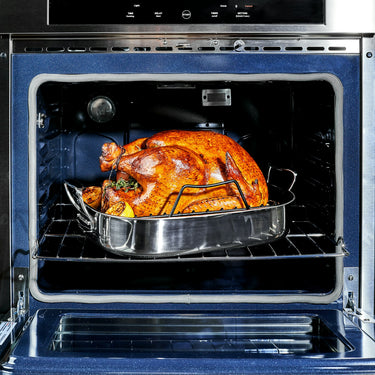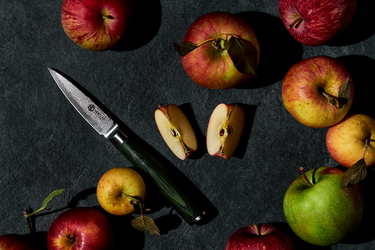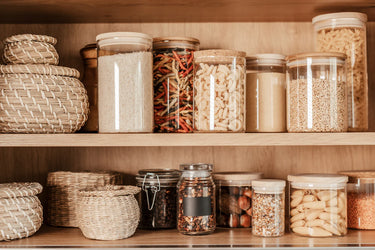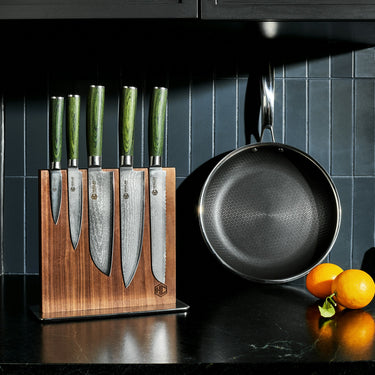Best Turkey Roasting Pan With Even Heat Distribution

There may be a certain holiday that is more associated with turkey than others, but it can still be enjoyed year-round.
Whether you’re roasting this big bird on Turkey Day or any other day of the year, you need the equipment to do it right.
How Is a Roasting Pan Different From a Baking Pan?
A baking pan is typically flat with low sides. Meanwhile, a quality roasting pan is specifically made to handle heavy-duty food like casseroles, lasagna, and turkeys.
As a result, they often come with riveted or stainless steel handles to help you move them in and out of the oven. Roasting pans are also complete with high sides so that they can accommodate larger dishes.
What Are the Best Roasting Pan Materials for Turkey?
These materials all provide their own advantages and disadvantages for crafting the perfect turkey dinner, but they really shine when combined.
Non-Stick
Nobody, we mean nobody, wants to deal with the inconvenience of cleaning food off the bottom of a sticky pan. That’s where non-stick cookware comes in.
Unfortunately, the typical non-stick coating can contain toxic chemicals. That’s why it was so important for us at HexClad to keep our pots and pans completely free of dangerous chemicals.
Stainless Steel
There is perhaps no material more reliable, durable, and versatile than stainless steel.
You can rest assured that a turkey made in this type of roasting pan will be excellent, but there’s still some room for improvement.
Cast Iron
Cast iron retains heat famously well, allowing you to get a deliciously crispy outside of whatever you’re cooking.
However, this material is infamously heavy, making it difficult to maneuver around. This is especially noticeable when moving an already heavy turkey in and out of the oven.
What Is a Hybrid Pan?
A hybrid pan is one that delivers the advantages of multiple different types of cookware all in one.
HexClad offers the quality of all-clad stainless steel construction, the ruggedness of cast iron, and the convenience of a non-stick pan in one sleek package. Our roasting pan is no exception.
The non-stick coating is safe and effective, while the hexagonal design within the pans and skillets make them that much more striking.
Should You Add Water to the Bottom of a Roasting Pan?
It is a common question for people to wonder if they should put water in the bottom of their roasting pan before cooking a turkey.
We understand where this impulse might come from — after all, it stands to reason that adding water would theoretically infuse more moisture into the whole turkey. Right?
We actually recommend not adding any water to the bottom of the pan. The water will evaporate and end up steaming the turkey breast, roast chicken, veggies, or anything else you are cooking. Since the goal isn’t to steam the dish, you should allow your roaster pan to do what it does best — roast.
Roasting relies on a dry heat, which is immediately taken away the second that water is added into the mix. If you want your Thanksgiving turkey to have a deliciously crispy skin right out of the oven, not adding water is the most effective way to do it. If you’re worried about keeping your turkey sufficiently moist, we recommend basting the meat every 30 to 40 minutes.
You can easily baste your turkey by collecting the drippings and liquids that naturally accumulate at the bottom of the baking dish throughout the cooking process. You can carefully use a spoon, or you can use an aptly named turkey baster for the task.
Of course, all of this advice goes out the window if you are actually looking to steam whatever is in your roasting rack. In that case, you can add some water to the bottom of the pan and cover it with aluminum foil.
After the inside is sufficiently moist and cooked, you can take off the aluminum foil. This will allow the outside to brown and caramelize, giving you a delicious juxtaposition of flavors.
How Long Does It Take To Roast Turkey in a Roasting Pan?
This question is a bit loaded, and it’s because there are so many different components that go into how long you should roast your turkey. You have to consider how large and heavy the turkey is, as well as what temperature you are roasting it at.
For instance, an extra large bird, like a 20-pound turkey or higher, will require anywhere from four to five and a half hours.
The size of the bird isn’t the only consideration to keep in mind, though. Some ovens heat more evenly than others. If you have a particularly finicky oven, your turkey might need more time before it’s just right.
While you might not be able to control the evenness of the oven itself, you can make sure that you have a stainless steel roasting pan that will help you on your way.
All of the cookware and bakeware by HexClad has an even heat distribution, meaning that all sides of your dish will be cooked at the same rate.
This is crucial no matter what you are making, but it’s especially important with something like turkey, which can get dried out at the drop of a hat.
Being oven-safe is the bare minimum for a pan to get your turkey cooking, you need a reliable and versatile nonstick roaster that will help you get the best final product every time.
Many people like to roast their turkey at 350 degrees Fahrenheit since this temperature is hot enough to cook even a large turkey, but not so hot that it blasts any moisture straight out.
At this temperature, a good rule of thumb to remember is that the turkey needs 13 minutes of cooking time per pound of meat or 15 minutes per pound if the turkey is stuffed. As with other poultry, the USDA recommends that turkey needs to reach an internal temperature of 165 degrees Fahrenheit before it is safe to eat.
Should a Roasting Pan Be Covered?
If you are thinking about putting aluminum foil over the bottom of the roasting pan, we’re begging you not to. The non-stick hybrid technology of HexClad roasting pans was quite literally made for this, so let it do its thing.
If you’re thinking about covering the turkey in the pan, that’s a slightly different story.
Many people like to put aluminum foil over the top of their turkey to avoid the skin getting too brown too quickly. Nothing is worse than when the skin is perfectly crispy, but the meat still has several hours to go. Using aluminum foil to deflect some of the more direct heat can help you avoid this tragic fate.
Remove the aluminum foil from the top of the bird about halfway through cooking, then keep an eye on the skin’s progression afterward. If you notice it browning faster than you expected, you can pop the aluminum foil back on.
How Do You Clean a Roasting Pan?
If you’re wondering how to clean a HexClad roasting pan, the answer is: easily.
Since it’s made of non-stick, hybrid material, vegetables and drippings should slide out with little to no hassle. On a busy Thanksgiving Day, this can make all the difference. Kids may be screaming, and your aunt drank way too much wine, but at least the carrots are cooperating.
Once the roasting pan has served its purpose and helped you deliver a turkey for the ages, the process remains blessedly simple. All of HexClad’s cookware is dishwasher safe. That’s right, cleaning off the pan and non-stick rack is a breeze.
Cleaning your aunt off the floor might be more of a challenge, but that’s not our department.
HexClad: Versatile Cookware for Versatile Chefs
If you’re hosting Thanksgiving for the first time or if you’re already a seasoned pro, cooking using HexClad is sure to wow your guests.
Sources:
How To Baste a Turkey | Thanksgiving How-Tos | Food Network
Our Ultimate Guide to Cooking the Easiest Thanksgiving Turkey | EpiCurious
Keep Your Thanksgiving Full of Turkey and Free From Foodborne Illness | USDA





